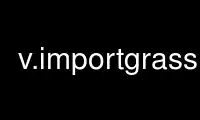
This is the command v.importgrass that can be run in the OnWorks free hosting provider using one of our multiple free online workstations such as Ubuntu Online, Fedora Online, Windows online emulator or MAC OS online emulator
PROGRAM:
NAME
v.import - Imports vector data into a GRASS vector map using OGR library and reprojects
on the fly.
KEYWORDS
vector, import, projection
SYNOPSIS
v.import
v.import --help
v.import [-fl] input=name [layer=string[,string,...]] [output=name] [extent=string]
[encoding=string] [snap=float] [epsg=integer] [datum_trans=integer] [--overwrite]
[--help] [--verbose] [--quiet] [--ui]
Flags:
-f
List supported OGR formats and exit
-l
List available OGR layers in data source and exit
--overwrite
Allow output files to overwrite existing files
--help
Print usage summary
--verbose
Verbose module output
--quiet
Quiet module output
--ui
Force launching GUI dialog
Parameters:
input=name [required]
Name of OGR datasource to be imported
layer=string[,string,...]
OGR layer name. If not given, all available layers are imported
output=name
Name for output vector map (default: input)
extent=string
Output vector map extent
Options: input, region
Default: input
input: extent of input map
region: extent of current region
encoding=string
Encoding value for attribute data
snap=float
Snapping threshold for boundaries (map units)
’-1’ for no snap
Default: 1e-13
epsg=integer
EPSG projection code
Options: 1-1000000
datum_trans=integer
Index number of datum transform parameters
-1 to list available datum transform parameters
Options: -1-100
DESCRIPTION
v.import imports selected layers from a OGR vector datasource into the current location
and mapset. If the projection of the input does not match the projection of the location,
the input is reprojected into the current location. If the projection of the input does
match the projection of the location, the input is imported directly with v.in.ogr.
NOTES
Topology cleaning
When importing polygons, non-topological polygons are converted to topological areas. By
default, a very small snapping threshold is applied (1e-13 map units) to avoid topological
errors caused by numerical inaccuracy of the input data format. If the original polygons
contain errors (unexpected overlapping areas or small gaps between polygons), the import
might need to be repeated using a larger snap value.
EXAMPLE
# import SHAPE file at full extent and reproject to current location projection
v.import input=research_area.shp output=research_area extent=input
Use v.importgrass online using onworks.net services
